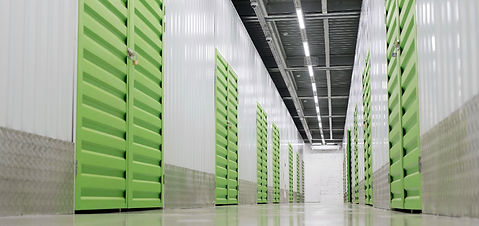
COLD STORAGES & COLD ROOMS

Cold storage and cold rooms are essential facilities for preserving perishable products like food, pharmaceuticals, and other temperature-sensitive items. These environments are designed to maintain controlled temperatures ranging from slightly below ambient to sub-zero, depending on the storage needs.
The construction of cold storage facilities involves materials and technologies that ensure effective insulation, energy efficiency, and temperature regulation.

Key Components of Cold Storages and Cold Rooms
1. Insulation Panels PIR/PUR Insulated Panels: PIR (Polyisocyanurate) Panels: Offer superior thermal insulation and fire resistance, making them ideal for cold storage where temperature control and fire safety are critical. PUR (Polyurethane) and PUF (Polyurethane Foam) Panels: Commonly used due to their excellent thermal insulation properties, though they have slightly lower fire resistance compared to PIR. Insulated panels form the walls, floors, and ceilings of cold rooms and help maintain the internal temperature, reduce heat transfer, and lower energy costs. 2. Cooling Systems: Cold rooms and cold storage facilities use powerful refrigeration systems to regulate and maintain the required temperature. These systems often include: Evaporators: Located inside the cold room to absorb heat from the air. Condensers: Situated outside the room, releasing heat into the environment. Compressors: To circulate refrigerants through the system, helping remove heat from the internal space. 3. Vapor Barrier: Vapor barriers prevent moisture infiltration, which could affect insulation and lead to mold or ice buildup. Cold storage rooms use specialized membranes or coatings to ensure airtightness and minimize condensation. 4. Flooring: Cold room floors need to be both insulated and durable to withstand heavy loads. Often, special insulated panels or concrete floors with insulation layers are used. Anti-slip surfaces and coatings are applied for safety. 5. Doors: Insulated Doors: Cold storage doors are typically insulated to match the thermal performance of the walls. They are airtight, preventing the escape of cold air and the entry of warm air. Automated or Sliding Doors: To minimize temperature fluctuation and energy loss during entry and exit. 6. Humidity Control: Some cold storage facilities require humidity control to prevent product degradation. Humidifiers or dehumidifiers are used to maintain optimal conditions for different products, such as fruits, vegetables, or pharmaceuticals. 7. Monitoring and Control Systems: Advanced cold rooms use digital monitoring systems to track temperature and humidity levels continuously. Automated alerts are generated if temperature thresholds are breached, ensuring that products remain within their safe storage parameters.


Types of Cold Storages
and Cold Rooms
1. Chilled Storage (0°C to 5°C): Used for storing fresh products like fruits, vegetables, dairy, and meat. Ensures products remain fresh by slowing down the spoilage process caused by bacteria. 2. Frozen Storage (−18°C to −25°C): Used for long-term storage of frozen food items, including meat, seafood, and ice cream. Ensures preservation by halting bacterial growth. 3. Blast Freezers (−30°C to −40°C): Used to rapidly freeze products, locking in freshness and nutrients. Commonly used in food processing industries where quick freezing is essential to maintain product quality. 4. Pharmaceutical Cold Rooms: Designed for storing temperature-sensitive drugs, vaccines, and medical supplies. Must comply with stringent regulations, maintaining precise temperature control (e.g., 2°C to 8°C for vaccine storage). 5. Walk-in Cold Rooms: Larger storage spaces used in restaurants, supermarkets, and industrial settings. These rooms allow personnel to enter and manage stored goods easily. 6. Modular Cold Rooms: Flexible, prefabricated rooms that can be quickly assembled and disassembled. These are ideal for temporary or expanding cold storage needs.


Applications of Cold Storages and Cold Rooms
1. Food Industry: Essential for preserving perishable products like fresh produce, dairy, meat, poultry, seafood, and frozen food items. Cold storage helps maintain food quality, prolong shelf life, and prevent food waste. 2. Pharmaceutical Industry: Cold rooms are vital for maintaining the efficacy of vaccines, drugs, and biological samples that need precise temperature control. Used for the storage of life-saving medications and sensitive medical materials like blood plasma. 3. Horticulture and Floriculture: Cold storage rooms are used to preserve flowers, plants, and seeds by slowing down the natural degradation process. 4. Beverage Industry: Used for storing wine, beer, and other beverages that require a controlled environment to maintain flavor and quality. 5. Dairy and Meat Processing: Cold storage rooms are essential in dairy plants and meat processing facilities to ensure the freshness of products from production to transportation. 6. Cold Chain Logistics: Cold storage plays a critical role in cold chain logistics, ensuring that temperature-sensitive goods remain safe and effective throughout their supply chain journey, from production to consumer.


Benefits of Cold Storages & Cold Rooms
1. Energy Efficiency: Modern cold storage facilities use highly insulated materials (such as PIR and PUR panels) that reduce heat transfer, lowering energy consumption and operational costs. 2. Product Preservation: By maintaining stable temperatures, cold rooms preserve the quality, texture, and nutritional value of perishable items for longer periods. 3. Compliance with Regulations: Cold storage facilities help industries meet food safety and pharmaceutical regulations by providing the correct storage environment for sensitive products. 4. Cost Savings: Prolonged shelf life and reduced spoilage result in fewer losses, saving companies money over time.
Challenges and Considerations
1. Energy Consumption: Cold storage facilities require significant energy, especially in larger installations. Selecting energy-efficient refrigeration systems and insulated materials is crucial. 2. Maintenance: Regular maintenance of refrigeration equipment and insulation systems is vital to ensure efficiency and avoid costly breakdowns. 3. Initial Investment: The construction of cold rooms involves a considerable initial investment in refrigeration systems, insulated panels, and monitoring technologies. 4. Temperature Management: Accurate temperature control is critical to avoid spoilage or damage to stored products, especially in the pharmaceutical and food industries.
